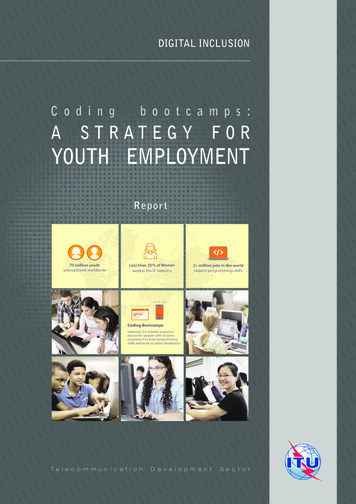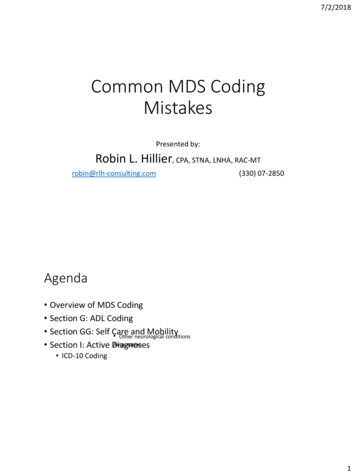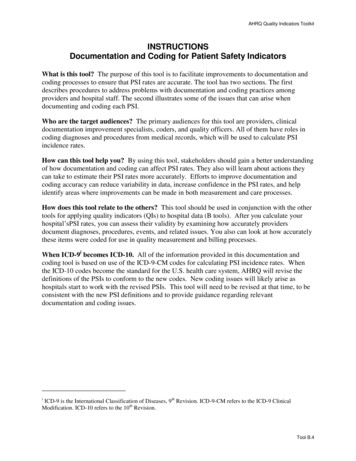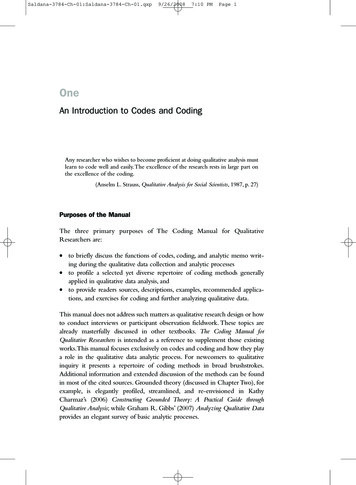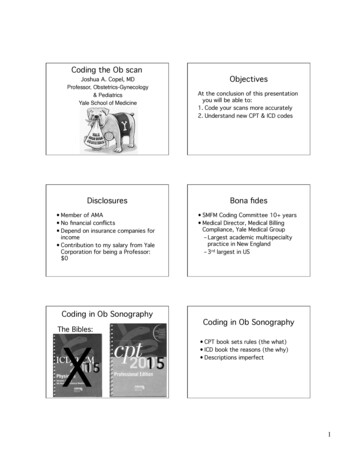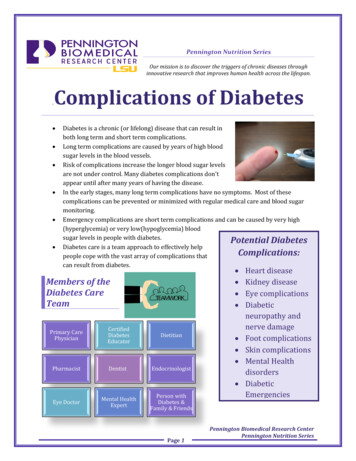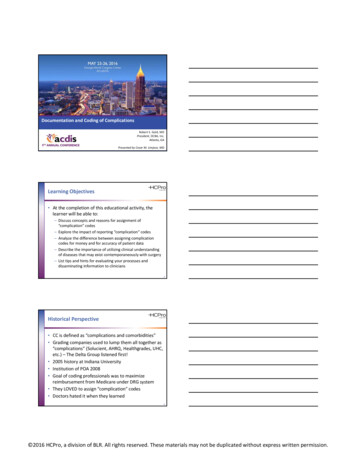
Transcription
Documentation and Coding of ComplicationsRobert S. Gold, MDPresident, DCBA, Inc.Atlanta, GAPresented by Cesar M. Limjoco, MD1Learning Objectives At the completion of this educational activity, thelearner will be able to:– Discuss concepts and reasons for assignment of“complication” codes– Explore the impact of reporting “complication” codes– Analyze the difference between assigning complicationcodes for money and for accuracy of patient data– Describe the importance of utilizing clinical understandingof diseases that may exist contemporaneously with surgery– List tips and hints for evaluating your processes anddisseminating information to clinicians2Historical Perspective CC is defined as “complications and comorbidities” Grading companies used to lump them all together as“complications” (Solucient, AHRQ, Healthgrades, UHC,etc.) – The Delta Group listened first! 2005 history at Indiana University Institution of POA 2008 Goal of coding professionals was to maximizereimbursement from Medicare under DRG system They LOVED to assign “complication” codes Doctors hated it when they learned3 2016 HCPro, a division of BLR. All rights reserved. These materials may not be duplicated without express written permission.
What We’re Talking About Every day CDI specialists and coding professionalsstruggle with the question: Is this a complication or anexpected outcome of surgery? With an increase in publicly reported physician andhospital data, accurately reporting complications isvital to the reputations of your surgeons and yourfacility. Hear from a former surgeon about common stumblingblocks, such as postoperative ileus and accidentalpunctures and lacerations, with suggestions forresolution.4Complications That May or May Not Be Ileus Atelectasis Anemia of acute bloodloss (ABLA) CAUTI Acute renal failure (ATNor not?) Encephalopathy Cardiogenic shock Wound infection Retained surgical item Iatrogenicpneumothorax nundrum in ICD‐10) Respiratory failure Postoperative sepsis Wound dehiscence Accidental laceration5Who’s Measuring? Hospital Compare ityInits/HospitalCompare.html AHRQ (PSIs) http://qualityindicators.ahrq.gov/Modules/psi overview.aspx Joint ce measurement.aspx UHC (University Health System lity‐performance Private companies– Leapfrog– Healthgrades– Consumer Reports– Comparison analytics– Crimson/The Advisory Board – US News/Parents magazine6 2016 HCPro, a division of BLR. All rights reserved. These materials may not be duplicated without express written permission.
Potential Effects1. Financiala) CC or MCC capture may lead to increased reimbursement forhospital billing purposes for PSIs and other complications orresults of careb) At start of DRG system, coders encouraged to identify all “CC”sso as to maximize Medicare reimbursementc) With conversion to HACs, hospital will have reduced paymentswith identification of “complications of care”2. Honest, ethical profilesa) Hospital reputation depends on determination of value‐basedservicesb) Hospital and physician reputations will suffer – lose marketshare7Long‐Term Effects for Inadequate Homework How doctors and hospitals have collected billions in questionableMedicare fees Center investigation suggests costs from upcoding and other abuseslikely top 11 billion Medical billing a target of fraud investigations “Upcoding” problem contributes to Medicare fraud Kitchen sink coding. Though technically only confirmed diagnosescan be coded, physicians often throw in other codes, called kitchensink coding. Providers may have a poor understanding of codingguidelines or may be justifying various treatments or exaggeratinginjuries. This practice can hurt patients in the long run by creatingpreexisting conditions they may never actually have had. Upcoding can cost you money and your health Learn about this fraudulent practice and help put a stop to it8Considerations When an Event Is Noted Look for conditions (diseases) that were present onadmission, even if inadequately documented Look for conditions caused by the disease itself and not bythe surgery Look for conditions caused by some other issue and totallyunrelated to the surgery Distinguish events caused by the surgery versus eventscaused by medications or anesthesia Look for incidental findings when doc states“complications” or “complicated by” Use your clinical acumen and NOT coding desires, whetheryou are a coder or nurse! Clinical truth!!! Be sure it meets UHDDS criteria as a valid code!9 2016 HCPro, a division of BLR. All rights reserved. These materials may not be duplicated without express written permission.
Complications That May or May Not Be Ileus Atelectasis Anemia of acute bloodloss (ABLA) CAUTI/VAP/CLABSI Acute renal failure (ATNor not?) Encephalopathy Cardiogenic shock Wound infection Retained surgical item Iatrogenicpneumothorax nundrum in ICD‐10) Respiratory failure Postoperative sepsis Wound dehiscence Accidental laceration10Ileus Ileus has two models: Obstructive and paralytic Ileus occurs after almost all abdominal surgeries – physiologic response– all patients treated NPO and then advanced in diet when bowelactivity returns Ileus occurs with all patients with abdominal trauma and perforationcaused by the trauma or any perforation or infected process – that’swhat causes them to vomit Admission with ileus caused by inflammatory process will have ileusafter surgery caused by the same process (pancreatitis, appy, acute GB,Crohn’s disease, perforated tic, etc.) – not the surgery Obstructive ileus caused by surgery is due to inadequate surgery or amajor vascular event – patient returns to OR for surgery Paralytic ileus may be associated with perforation, infection, deadbowel, abscess that was not POA – they return to OR or haveinterventional procedure Paralytic ileus may be due to patient’s autonomic neuropathy and notdue to the surgery, but delay caused by diabetes or other neuropathy11Complications That May or May Not Be Ileus Atelectasis Anemia of acute bloodloss (ABLA) CAUTI/VAP/CLABSI Acute renal failure (ATNor not?) Encephalopathy Cardiogenic shock Wound infection Retained surgical item Iatrogenicpneumothorax nundrum in ICD‐10) Respiratory failure Postoperative sepsis Wound dehiscence Accidental laceration12 2016 HCPro, a division of BLR. All rights reserved. These materials may not be duplicated without express written permission.
Atelectasis Atelectasis may exist preop in morbidly obese patients (obesityhypoventilation syndrome) or patients with obstructive airwaydisease (bronchiectasis, cystic fibrosis) or other obstruction(malignancy, foreign body, stricture) All patients after major chest surgery may have atelectasis seenon postop chest film All patients after major chest surgery have incentive spirometryand ambulation or turning or chest PT ordered – this ispreventative or treatment for incidental finding of atelectasisand does not meet UHDDS criteria as a valid diagnosis When patient requires additional intervention (nasotrachealsuctioning, bronchoscopy, drainage of air or fluid collection inchest causing collapse of lung), then it’s codable Pneumonia after surgery stated in area of atelectasis is NOThypostatic pneumonia – it’s bacterial – all Rx with abx13Complications That May or May Not Be Ileus Atelectasis Anemia of acute bloodloss (ABLA) CAUTI/VAP/CLABSI Acute renal failure (ATNor not?) Encephalopathy Cardiogenic shock Wound infection Retained surgical item Iatrogenicpneumothorax nundrum in ICD‐10) Respiratory failure Postoperative sepsis Wound dehiscence Accidental laceration14ABLA‐BLA‐BLA First of all, make sure it’s anemia and not lower Hb thatdoes not represent “anemia” “Significant drop in hemoglobin” is an outpatient term, abogus code in the hospital – code the cause!!! Patients may come in for elective or emergency surgerywith preexisting anemia of various causes– Anemia of CKD, sickle cell anemia, iron deficiency anemia Often you will see low hemoglobin to begin with andminimal blood loss leading to low postop hemoglobin –was the anemia or transfusions caused by the surgerywhen 50 cc EBL? Too many times patient receives 3,000 cc crystalloid andhas minimal blood loss, but HB after surgery issignificantly lower due to hemodilution15 2016 HCPro, a division of BLR. All rights reserved. These materials may not be duplicated without express written permission.
Difference Between Complication PSI‐9and Event Hemorrhagic complication of a procedure implies thatthere was unexpected bleeding during or after theinvasive procedure Significant bleed may have led to the need for theprocedure:– Ruptured aortic aneurysm.– Bleeding esophageal varices or diverticulum or angiodysplasia.– Multiple trauma with fractures, ruptured spleen, liver, lacerationof omentum.– These patients may not be seen to have anemia untilresuscitation or after the operative procedure. WHY? Entering belly or chest involves cutting and controllingbleeding on the way in16Half Full or Half 7PSI‐9 Is Postoperative Hemorrhage orHematoma vs. Intraoperative PSI‐9 reporting limited to return to procedure room forcontrol of bleed or for drainage of a hematoma Exclude cases:– With principal diagnosis of postoperative hemorrhage orpostoperative hematoma or secondary diagnosis present onadmission– Where the only operating room procedure is postoperativecontrol of hemorrhage or drainage of hematoma– Where a procedure for postoperative control of hemorrhage ordrainage of hematoma occurs before the first operating roomprocedure Note: If day of procedure is not available in the input datafile, the rate may be slightly lower than if the informationwas available– MDC 14 (pregnancy, childbirth, and puerperium)18 2016 HCPro, a division of BLR. All rights reserved. These materials may not be duplicated without express written permission.
311H59.312H59.313Postprocedural hemorrhage and hematoma of the spleen following aprocedure on the spleenPostprocedural hemorrhage and hematoma of the spleen followingother procedurePostprocedural hemorrhage and hematoma of an endocrine systemorgan or structure following an endocrine system procedurePostprocedural hemorrhage and hematoma of an endocrine systemorgan or structure following other procedurePostprocedural hemorrhage and hematoma of a nervous systemorgan or structure following a nervous system procedurePostprocedural hemorrhage and hematoma of a nervous systemorgan or structure following other procedurePostprocedural hemorrhage and hematoma of right eye and adnexafollowing an ophthalmic procedurePostprocedural hemorrhage and hematoma of left eye and adnexafollowing an ophthalmic procedurePostprocedural hemorrhage and hematoma of eye and adnexafollowing an ophthalmic procedure, bilateral19ICD‐10 Error to Be Dealt With A seroma is a clear fluid collection usually due to theprocess operated on or due to accumulation of serousfluid – a traumatic seroma is caused by tissue damagefrom the injury A hematoma is a blood collection usually related toexcessive bleeding at the site, either from the originalprocess or due to excessive bleeding – a traumatichematoma is caused by tissue damage from the injury A hemorrhage is significant bleeding – it may or may notlead to hematoma THESE ARE NOT THE SAME NOR DO THEY HAVE THE SAMEORIGINS AND SHOULD NOT BE THE SAME CODE20Bad Coding AdvicePostoperative SeromaCoding Clinic, First Quarter 2014 Page: 7Coding advice or code assignments contained in this issue effective with discharges March 31,2014.Question:How would a diagnosis of “postoperative seroma” be coded in ICD‐10‐CM?Answer:Currently, ICD‐10‐CM’s Index to diseases, directs the coder to see “hematoma” whenthe term “seroma” is referenced. The specific code assignment for postoperativeseroma would depend on the body system involved in the surgery. For example, codesin subcategory I97.6‐, Postprocedural hemorrhage and hematoma of a circulatorysystem organ or structure following a procedure, are assigned based on whether theseroma occurred following a cardiac bypass, cardiac catheterization or other circulatorysystem procedure.“See” does NOT always mean “code.” This must be fixed.The most common complication after abdominoplasty is seroma formation. The incidence of seromaformation in abdominal procedures as a whole, including abdominoplasty, panniculectomy, andtransverse rectus abdominis myocutaneous flap abdominal donor sites, ranges from 1% to 38%.21 2016 HCPro, a division of BLR. All rights reserved. These materials may not be duplicated without express written permission.
Complications That May or May Not Be Ileus Atelectasis Anemia of acute bloodloss (ABLA) CAUTI/VAP/CLABSI Acute renal failure (ATNor not?) Encephalopathy Cardiogenic shock Wound infection Retained surgical item Iatrogenicpneumothorax nundrum in ICD‐10) Respiratory failure Postoperative sepsis Wound dehiscence Accidental laceration22CAUTI – Catheter‐Associated UTI Was the patient admitted with a urinary catheter? What kinds of urinary catheters are there?–––––Foley catheter – continuous or intermittent?Suprapubic tube?Nephrostomy tube?Indwelling ureteral stent?Continent ileostomy for bladder substitute? Was the urine contaminated or is it infected?23CAUTI Virtually all healthcare‐associated UTIs are caused byinstrumentation of the urinary tract. CAUTI can lead to such complications as cystitis,pyelonephritis, Gram‐negative bacteremia, prostatitis,epididymitis, and orchitis in males and, lesscommonly, endocarditis, vertebral osteomyelitis,septic arthritis, endophthalmitis, and meningitis in allpatients. Read:http://www.cdc.gov/nhsn/PDFs/pscManual/2PSC IdentifyingHAIs NHSNcurrent.pdf24 2016 HCPro, a division of BLR. All rights reserved. These materials may not be duplicated without express written permission.
Commonalities Determination at which inpatient location the patient wasassigned when the specimen that met the infectioncriteria was collected, or when the first clinical evidence ofCLABSI, VAP, or CAUTI appeared. At which inpatient location was the patient assigned whenthe specimen that met the infection criteria was collected,or when the first clinical evidence of CLABSI, VAP, or CAUTIappeared? If the infection developed within 48 hours oftransfer from one location to one or more other locationswithin this facility, select the patient s first such inpatientlocation within the 48‐hour period where the central line,urinary catheter, or ventilator was used.25Commonalities Present on admission (POA): Infections that are POA, asdefined in Chapter 2, are not considered HAIs andtherefore are never reported to NHSN Healthcare‐associated infections (HAI): All NHSN site‐specific infections must first meet the HAI definition asdefined in Chapter 2 before a site‐specific infection (e.g.,CAUTI) can be reported to NHSN Organisms belonging to the following genera are typicallycauses of community‐associated infections and are rarelyor are not known to be causes of healthcare‐associatedinfections; they are excluded and cannot be used to meetany NHSN definition: Blastomyces, Histoplasma,Coccidioides, Paracoccidioides, Cryptococcus, andPneumocystis26Commonalities If the date of culture collection is on or after the date the patient is declaredbrain dead AND the patient is being supported for organ donationpurposes, the event should not be reported as an HAI. For VAE surveillance,if the date of event (date of onset of worsening oxygenation) is on or afterthe date the patient is declared brain dead AND the patient is beingsupported for organ donation purposes, the event should not be reportedas a VAE. An infection is considered present on admission (POA) if the date of eventof the NHSN site‐specific infection criterion occurs during the POA timeperiod, which is defined as the day of admission to an inpatient location(calendar day 1), the 2 days before admission, and the calendar day afteradmission. For purposes of NHSN surveillance and determination of theRepeat Infection Timeframe (as defined below) if the date of event isdetermined to be either of the two days prior to inpatient admission, thenthe date of event will be hospital day 1. An infection is considered a healthcare‐associated Infection (HAI) if thedate of event of the NHSN site‐specific infection criterion occurs on or afterthe 3rd calendar day of admission to an inpatient location where day ofadmission is calendar day 1.27 2016 HCPro, a division of BLR. All rights reserved. These materials may not be duplicated without express written permission.
When It IS and Isn’tHospital dayDate of eventClassificationAssignment for RIT2 days before admitHospital Day 11 day before admitHospital Day 11Hospital Day 12Hospital Day 23Hospital Day 34Hospital Day 45Hospital Day 5POAHAI28Examples – CAUTI or Not29Complications That May or May Not Be Ileus Atelectasis Anemia of acute bloodloss (ABLA) CAUTI/VAP/CLABSI Acute renal failure (ATNor not?) Encephalopathy Cardiogenic shock Wound infection Retained surgical item Iatrogenicpneumothorax nundrum in ICD‐10) Respiratory failure Postoperative sepsis Wound dehiscence Accidental laceration30 2016 HCPro, a division of BLR. All rights reserved. These materials may not be duplicated without express written permission.
AKI After IV Contrast (Dye‐Related/Contrast‐Induced Nephropathy) Definition: Acute kidney injury must meet criteria foracute kidney injury from AKIN Persistent creatinine over 0.3 from benchmark afteradequate fluid hydration lasting 24 hours and NOTrise in creatinine with patient going home in an hour Must meet UHDDS criteria as valid diagnosis:–––––Clinical evaluation; orTherapeutic treatment; orDiagnostic procedures; orExtended length of hospital stay; orIncreased nursing care and/or monitoring31Incidental Lab Variance or True Injury? CIN is normally a transient process, with renal functionsreverting to normal within 7–14 days of contrastadministration. Less than one‐third of patients developsome degree of residual renal impairment. Dialysis is required in less than 1% of patients, with aslightly higher incidence in patients with underlying renalimpairment (3.1%) and in those undergoing primary PCIfor myocardial infarction (MI) (3%). However, in patientswith diabetes and severe renal failure, the rate of dialysiscan be as high as �overview#a7Patients going into study dehydrated and areat higher risk – prevention is key32Is It Proper to Ask for ATN? Contrast media induce various factors that may increase vasoconstriction anddecrease vasodilatation in the renal medulla, leading to hypoxia and acutetubular necrosis known as contrast‐induced nephropathy (CIN) that tends tooccur in diabetics and patients with preexisting renal insufficiency. ATN follows a well‐defined three‐part sequence of initiation, maintenance,and recovery (see Pathophysiology). The initiation phase is characterized byan acute decrease in glomerular filtration rate (GFR) to very low levels, with asudden increase in serum creatinine and blood urea nitrogen (BUN)concentrations. The maintenance phase is characterized by a sustained severe reduction inGFR that persists for a variable length of time, most commonly 1–2 weeks.Because the filtration rate is so low during the maintenance phase, thecreatinine and BUN levels continue to rise. The recovery phase, in which tubular function is restored, is characterized byan increase in urine volume (if oliguria was present during the maintenancephase) and by a gradual decrease in BUN and serum creatinine to theirpreinjury levels.If the patient’s kidneys don’t meet these criteria, it’s unethicaland really LEADING to ask for ATN33 2016 HCPro, a division of BLR. All rights reserved. These materials may not be duplicated without express written permission.
Complications That May or May Not Be Ileus Atelectasis Anemia of acute bloodloss (ABLA) CAUTI/VAP/CLABSI Acute renal failure (ATNor not?) Encephalopathy Cardiogenic shock Wound infection Retained surgical item Iatrogenicpneumothorax nundrum in ICD‐10) Respiratory failure Postoperative sepsis Wound dehiscence Accidental laceration34Intent of the Codes for EncephalopathyA condition of nontraumatic damage to brain function,involving chemical interference with cells or neurons that, ifnot treated, will lead to death of brain tissue and function NOT something that will resolve by itself with nointerference NOT normal, expected effects or medications taken inproper dosage or anesthetic agents NOT short‐term effects of getting drunk or high on illegaldrugs NOT effects of stroke, NOT post‐ictal state, NOT syncope,NOT standard AMS NOT psychologic effects of mental illness35Error in Advice Metabolic encephalopathy is always due to anunderlying cause. There are many causes ofmetabolic encephalopathy, such as brain tumors,brain metastasis, cerebral infarction or hemorrhage,cerebral ischemia, uremia, poisoning, systemicinfection, etc. Metabolic encephalopathy is also acommon finding in 12‐33% of patients suffering frommultiple organ failure. The development of metabolicencephalopathy may be the first manifestation of acritical systemic illness and may be caused by variousreasons—one of the most important being sepsis.– Coding Clinic, Fourth Quarter 200336 2016 HCPro, a division of BLR. All rights reserved. These materials may not be duplicated without express written permission.
Common Errors There is no such thing as toxic metabolicencephalopathy Patient not responding well from anesthesia – yet Patient overmedicated from various sources –sedatives, hypnotics, tranquilizers, pain meds Syncopal episode – obvious vasovagal response Confusion or “AMS” in face of minor UTI Drunk kid, not responsive at risk of vomiting and notprotecting airway (also improperly called “acuterespiratory failure”)37Distinguish Encephalopathy From Coma Hepatic encephalopathy can get bad enough tobecome hepatic coma, but not all hepaticencephalopathies are comatose. (Hepatic encephalopathy (HE)represents a broad continuum of neuropsychological dysfunction in patients with acute or chronicliver disease and/or porto‐systemic shunting of blood flow, and it manifests with progressivedeterioration of the superior neurological functions.) Diabetic (hyperglycemic or hypoglycemic)encephalopathy can get bad enough to becomediabetic coma, but not all diabetic encephalopathypatients are comatose. (Mild variations in blood sugar levels will cause changesin mental acuity or dizziness or sleepiness in patients that responds to time or a Tootsie Roll – this isNOT metabolic encephalopathy.) Patients on lactulose may or may not have codablehepatic encephalopathy DESPITE what codingguidelines imply!!!38If Stage 0, Does Not HaveEncephalopathy (Now)Stage Consciousness Intellect and behaviourNeurological findings0NormalNormal1Trivial lack ofawarenessImpaired attention span;Mild asterixisaltered sleep; euphoria2LethargicDisoriented;inappropriate behaviourdepression3Somnolent but Gross disorientation;arousablebizarre behaviourMuscularrigidity/clonus hyper‐reflexia4ComaDecerebrate posturingComaNormal examinationAsterixis; slurredspeech39 2016 HCPro, a division of BLR. All rights reserved. These materials may not be duplicated without express written permission.
Complications That May or May Not Be Ileus Atelectasis Anemia of acute bloodloss (ABLA) CAUTI/VAP/CLABSI Acute renal failure (ATNor not?) Encephalopathy Cardiogenic shock Wound infection Retained surgical item Iatrogenicpneumothorax nundrum in ICD‐10) Respiratory failure Postoperative sepsis Wound dehiscence Accidental laceration40Cardiac Function After Heart SurgeryMany adult patients require temporary inotropic support after cardiac surgery. The availableevidence, while limited in quality and scope, supports the following observations; although allβ‐agonists can increase cardiac output, the best studied β‐agonist and the one with the mostfavourable side‐effect profile appears to be dobutamine. Dobutamine and phosphodiesteraseinhibitors (PDIs) are efficacious inotropic drugs for management of the low cardiac outputsyndrome. Dobutamine is associated with a greater incidence of tachycardia andtachyarrhythmias, whereas PDIs often require the administration of vasoconstrictors. Othercatecholamines have no clear advantages over dobutamine.Pump perfusion with arterial return of the blood causes hypotension by endothelial NO (nitricoxide)‐release, which in turn is triggered by serotonin from activated platelets.Because ventricular dysfunction is common following cardiac surgery, inotropic drugs areoften necessary to improve hemodynamic status.Cardiopulmonary bypass can be associated with vasodilatory hypotension requiring pressorsupport.Off‐pump coronary artery bypass surgery (OPCAB) is widely performed for its benefit inreducing complications from cardiopulmonary bypass. However, since the surgical methodmoves the pumping heart and limits movement of the surgery site with a tissue stabilizer, itcan cause serious hemodynamic changes. For example, the function of both ventriclesdeclines due to pressure on the heart during OPCAB via diastolic dysfunction of the rightventricle due to pressure. 41Cardiogenic Shock The medical term "shock" refers to a state in which not enough blood and oxygenreach important organs in the body, such as the brain and kidneys. Shock causesvery low blood pressure and may be life threatening.Shock can have many causes. Cardiogenic shock is only one type of shock. Othertypes of shock include hypovolemic shock and vasodilatory shock.In vasodilatory shock, the blood vessels suddenly relax. When the blood vessels aretoo relaxed, blood pressure drops and blood flow becomes very low. Withoutenough blood pressure, blood and oxygen don’t reach the body’s organs.Sepsis or a severe allergic reaction or damage to the nervous system (brain andnerves) may cause vasodilatory shock.Vasodilatory shock was defined as a mean arterial pressure lower than 70 mm Hg, acardiac index greater than 2.5 L/min/m2, and norepinephrine dependence.Predictors of vasodilatory shock were investigated by logistic regression analysis.Vasoplegic syndrome is characterized by a severe and persistent form ofhypotension, tachycardia, normal or increased cardiac output, and decreasedsystemic vascular resistance (SVR) and low filling pressures, and is poorly responsiveor unresponsive to volume increase with fluid infusion.42 2016 HCPro, a division of BLR. All rights reserved. These materials may not be duplicated without express written permission.
What It Ain’t Use of low dose pressors during and immediatepostcardiac surgery to maintain perfusion to thekidneys, brain, lungs, liver, and heart is preventative –it does NOT represent cardiogenic shock. Cardiogenic shock means persistent drop in bloodpressure that does not respond to fluids and routinepressor usage. Postoperative cardiogenic shock (T81.11XA) andpostoperative shock (T81.10XA) are complications ofsurgery and will lead to poor reports for your heartsurgery team – they won’t like you!!!43Complications That May or May Not Be Ileus Atelectasis Anemia of acute bloodloss (ABLA) CAUTI/VAP/CLABSI Acute renal failure (ATNor not?) Encephalopathy Cardiogenic shock Wound infection Retained surgical item Iatrogenicpneumothorax nundrum in ICD‐10) Respiratory failure Postoperative sepsis Wound dehiscence Accidental laceration44Terms You Might See – What It Could Be CollectionPurulenceCloudy, thick fluidExudate Subcutaneous seroma Subcutaneous woundinfection Deep wound infection(muscle, fascia, bone)T81.4 Intra‐abdominal abscess following a procedurePostprocedural infection, not elsewhere classifiedSepsis following a procedureStitch abscess following a procedureSubphrenic abscess following a procedureWound abscess following a procedureUse additional code to identify infectionUse additional code (R65.2‐) to identify severe sepsis, if applicable45 2016 HCPro, a division of BLR. All rights reserved. These materials may not be duplicated without express written permission.
Expansion of T81.4 in the FutureAHIMA supports the proposed expansion of code T81.4, Infection following aprocedure, to capture specific types of surgical site infections. We alsorecommend a similar expansion of code O86.0, Infection of obstetric surgicalwound.T81.4 Infection following a procedureDelete Includes: Intra‐abdominal abscess following a procedureDelete Includes: Postprocedural infection, not elsewhere classifiedDelete Includes: Sepsis following a procedureDelete Includes: Stitch abscess following a procedureDelete Includes: Subphrenic abscess following a procedureIncludes: Wound abscess following a procedureUse additional code to identify infectionUse additional code (R65.2‐) to identify severe sepsis, if applicableExcludes1: Obstetric surgical wound infection (O86.0)Postprocedural fever NOS (R50.82)Postprocedural retroperitoneal abscess (K68.11)46Expansion of T81.4 in the FutureT81.40 Infection following a procedure, unspecifiedT81.41
Documentation and Coding of Complications 2 Learning Objectives At the completion of this educational activity, the learner will be able to: - Discuss concepts and reasons for assignment of "complication" codes - Explore the impact of reporting "complication" codes


